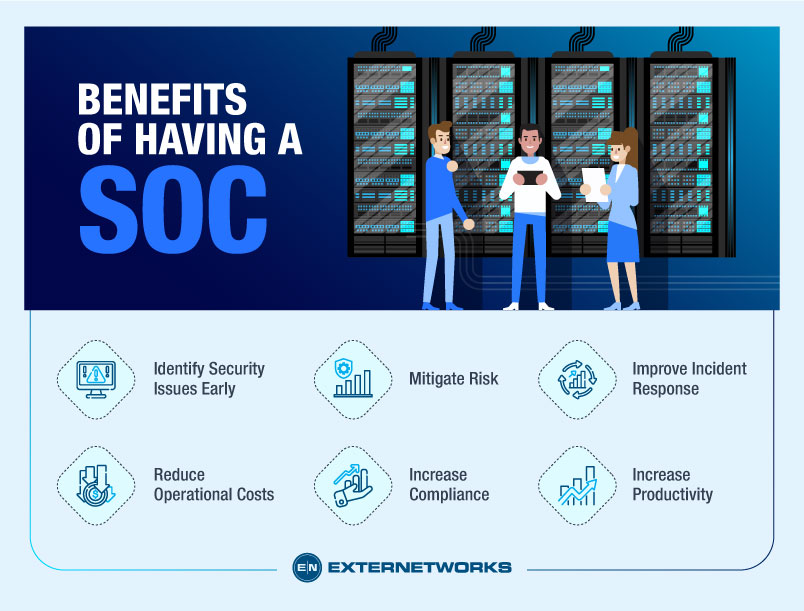Security Operations Centers (SOC) are becoming increasingly important to businesses across industries. They provide real-time threat intelligence, allowing organizations to proactively identify threats and take action before they impact their network or systems.
A SOC is a critical component of any modern cybersecurity strategy. In today’s complex environment, where cyberattacks are constantly evolving, it’s essential to have a robust security operation center.
A SOC is a centralized hub for monitoring all of your IT assets. It provides a single view into your entire Soc network and can be used to analyze activity on both physical and virtual devices.
This allows you to identify potential threats and respond accordingly quickly. The key advantage of having a SOC is that it can help you stay ahead of hackers by providing early warning about attacks.
The components of a SOC include:
The central console is the heart of the SOC. It collects data from various sources, including sensors, firewalls, routers, IDS/IPS, switches, etc., and presents this information in one location.
It’s usually located at the edge of the network so that it can receive data from multiple locations simultaneously. It aggregates all of this data and analyzes it with advanced algorithms to create a picture of what’s happening within the network.
The second part of the SOC is the network monitoring software. It helps you understand how traffic moves through your network and how much bandwidth each device consumes.
The software monitors everything from individual hosts to specific protocols like HTTP, FTP, SMTP, SSH, POP3, IMAP4, etc.
In addition, it can alert you when there are issues such as high CPU utilization, excessive memory usage, or low disk space.
Once you have collected the necessary data, it needs to be analyzed to determine if there is anything suspicious going on.
There are many different types of analytics tools available. Some focus more on detecting malicious behavior, while others focus on identifying vulnerabilities.
An example of a tool that detects malware would be a signature-based antivirus solution. These solutions look for known patterns associated with malware and flag them as suspicious activity.
On the other hand, vulnerability scanners will search others and focus on identifying trends and anomalies.
An example of a tool that detects malicious activity would be a honeypot. Honeypots are fake servers that look precisely like legitimate ones. Hackers will often try to compromise these servers to see if they can access other network parts.
They may learn valuable information about your company’s defenses if they do. On the other hand, if they don’t, they won’t know what to target next.
Intrusion detection systems (IDS) are another important element of an effective SOC. They monitor network traffic looking for signs of unauthorized activity.
They can also detect intrusions before they happen. This means you can take action before someone fully controls your network.
For instance, if you notice unusual activity on a particular port, you can block that connection without waiting for the hacker to complete his mission.
Finally, the last component of a good SOC is logging and storage capabilities. You need to record events that occur during normal operations. You should keep logs of any changes made to devices, configuration files,
This way, you can analyze problems later. If a server crashes, you can review its logs to find out why. You should also store copies of log files for 30 days, giving you time to investigate potential threats.
Having a SOC allows you to:
A SOC enables you to detect potential threats earlier, which means you can address them sooner instead of later. The sooner you know about a problem, the easier it is to fix it.
A SOC provides visibility into your environment. It helps you identify risks and prioritize them appropriately. It also lets you implement policies and procedures that reduce the likelihood of attacks.
A SOC allows you to respond to incidents faster, reducing downtime and improving customer satisfaction.
A SOC helps you manage resources effectively and efficiently. By identifying unused servers or applications, you can cut back on expenses.
A SOC ensures you comply with regulations like HIPAA and PCI DSS. You can use it to ensure that your organization is following best practices.
A SOC gives administrators the ability to perform routine tasks without being interrupted. It also helps you avoid having to spend time troubleshooting common problems.

In conclusion, a SOC is a vital part of any enterprise network. It helps organizations stay ahead of emerging threats and maintain their competitive edge, and it can help you protect your most important assets and ensure your data remains secure.
